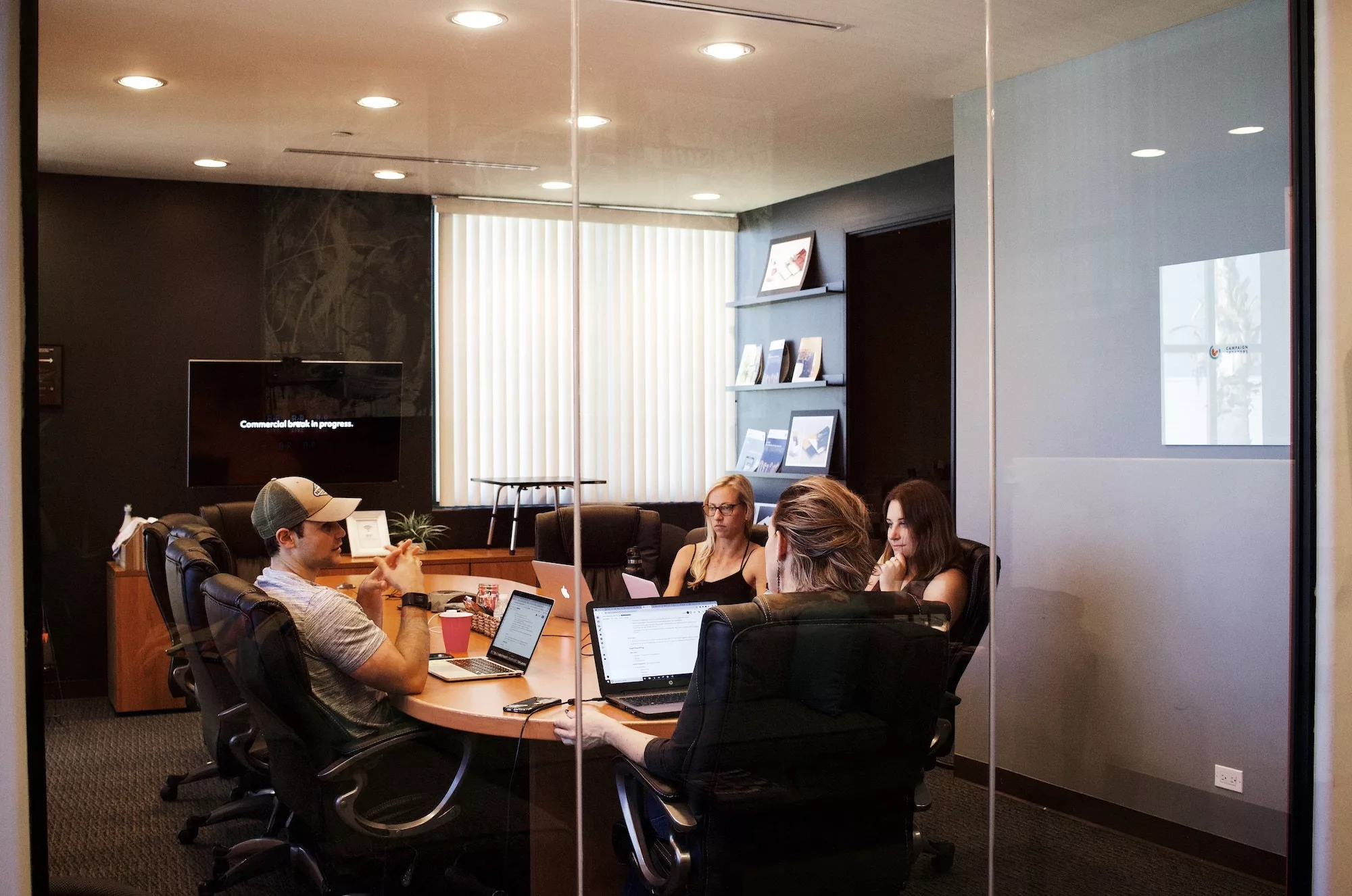Love is just a word — and yet, it’s a strong word, one that might help us counterbalance the sterile rules, boundaries, and roles we create at work. We can create a meaning for the word as it relates to how we show up at work. If we define love as being connected, compassionate, and openhearted with others, we have a framework for being in a state of love at work.
For me, love is a big “yes,” because it reminds me that I am one person — not just one of many personas, like work Aaron, leader Aaron, dad Aaron, and so on. Love and connection across all areas of life boil down to just one Aaron with no artificial boundaries. And if two people can approach each other from this “love” state, the need to be “sensitive” to each other diminishes and we can just be ourselves, relaxed and at ease, creating opportunities to more fully connect as people versus as roles in a process to get things done. We won’t offend one another because we can already assume our intentions come from a place of love. All of the political correctness just goes away. The best part is that we can be effective in the actual work we produce, as we now work at the speed of trust.
Recently, I have found that mindfulness-based approaches like self-awareness, conscious coaching, and circles can help us create the inner capacity to find these outer love connections. As I am always reminded, this is both a personal journey as well as a one in connection with others.
That’s my definition of love in the workplace. To get more perspective, I reached out to Lori Schwanbeck, a dear friend and renowned mindfulness teacher for global enterprises, to see what she her take is on the subject: “Love has generally been reduced in our Western world to either the realm of romance novels, eroticism, or within a family,” she said. “However, it is much more nuanced and simple than the stuff of hearts, flowers, or drama. Love, as I’m defining it, is about connection — those moments when we are touched by something outside of ourselves, when we feel the stirring of our hearts, and when we share these positive emotions.”
“The good news is that these moments of connection, of love, are available to us throughout our days, even at work. Love can come from feeling a shared sense of pride at a completed project, being touched by a kind gesture of a coworker, or expressing gratitude to a colleague for meeting a deadline. While these moments are great, we won’t really feel the full benefit of the shared connection and positivity in them unless certain conditions are happening. The first is being present — to be able to actually notice the connection and the uplift in mood that comes with it. The second is being able to pause and take in the positive feeling. The ability to be receptive is a different state than the chronically defensive and stressed mode many of us are in.”
Love and connection requires you to pay attention, and to be open and receptive to others and their ideas.
Love as a choice
I began to think of love as a choice in big and small moments of a day. Like the age-old saying goes: Everything comes down to choosing either love or fear. Love is the conscious, openhearted choice. Love is the decision that is open to all possibilities, not protective or closed off. Love is a choice that is connected and real.
In juxtaposition, fear aims to protect against failure or judgement from others. Fear keeps me safe in my own box. At work, we can ask, “Am I reacting to this person out of love or fear?” Take email, for example. So much of what we communicate via email is derived from fear. Either we are looking to unload a burden and delegate a task, or we are looking to lay blame, be right, and assume positive credit. Often, we filter email communication as if someone is attacking us, especially when the email is not so pleasant. With this in mind, we ask, “Okay, how do we incorporate that choice into our everyday chaotic work world?” Again, I turned to Lori for a bit of insight on the how.
“At a very basic level you can say there is a binary choice between love and fear,” she said. “And when we use that framework, we can see that there are very different parts of our nervous system engaged in each. When we are in a state that many people are in at work—of self-protection, competition, reaction, defensiveness, the need to prove ourselves — these are the behaviors and conditions that align with fear. In this fight-or-flight state, the part of our brain and nervous system that allows us to be open to others, consider diverse opinions, and collaborate and create are not accessible.”
“Being aware of the state we are in — fear or love — and shifting to a quality of presence that is more open, curious, and nonjudgmental allows us to access the part of ourselves that can feel the warmth and positivity of connection. We need to start with the intention of cultivating a quality of attention that is receptive and kind. And, the good news is that there are practices we can do to support this openness. These include: acts of gratitude, compassion, kindness, generosity. These actions prime the mind to be more open and receptive. This gets us out of the state of reactivity and self-preoccupation, making the quality of connection, of love, easier to access.”
But Lori, I asked, what is going on at a macro-level here? Are we just awful people when we walk in the door at work (or join our first Zoom call), or is there more at play in modern society? “Most of us are chronically stressed and overwhelmed,” she responded. “This creates distraction and reactivity and closes us in self-protection. Part of what is creating this stress is the increasing time we are spending on our devices and the constant pulls on our attention. The more we interact with and through screens, we become less present to the life around us, and we lose the opportunity for live connection where our nervous systems, and heart, benefit from the resonance of shared experience.”
“The work of psychologist and emotions researcher Barbara Fredrickson shows that when people are face-to-face and share a moment of positivity, their nervous systems enter into a state of synchrony. Barbara calls this moment ‘love.’ We literally expand beyond ourselves and become one with the other.”
“However, the statistics show that these micro-moments of face-to-face connection are reducing, and we have a global epidemic of loneliness and disengagement. When we intentionally encourage acts of kindness, compassion, and generosity in our workplaces, we are creating cultures of positivity where people’s wellbeing and psychological safety contributes to greater collaboration, creativity, and communication. These shared moments of positivity, of love, are good for us, and good for our organizations.”
What gets in our way? Can we rewire our habits and routine? Do we need to address some problems before we can get to the solutions? “We start with awareness,” Lori says. “Becoming aware of whether I am in a state of openness or reactivity. In my work with individuals and organizations, I teach mindfulness and compassion practices that support the cultivation of our best selves. These are skills that settle our reactive thoughts and impulses and replace with mindsets and behaviors that encourage optimism, self-acceptance, and compassion. When we are at our best, it’s easier to open and extend to others and share love.”
“It is also important to be aware of how good love feels,” she says. “We must remember how nourishing it is to feel connected, open, and engaged, and then create an intention to notice the moments in our life when this occurs. Pause to really feel them. They’re happening all the time. Noticing, pausing, and feeling supports installing these positive experiences into our memories. Through neuroplasticity, we are intentionally hardwiring happiness into our brains.”
“Beyond awareness, you can take action. You can intentionally prime the mind and heart for love through actions such as: extending kindness, helping someone out, expressing gratitude, and looking someone in the eye when they’re speaking (and don’t interrupt). Research, and common sense, show that these actions feel good for others, and feel good for us. These are the actions of love. Choose to notice when love is present. Choose to act in a way that supports connection where love can flourish.”
Love ourselves
The saying “you do you” implies that we are in a proper state to “be the real me,” a me that actually loves oneself. When we come from that place, our ability to bring love to others, especially in the workplace, becomes easy. We see authenticity and vulnerability flourish as a result of self-love. Moreover, for those coaching leaders, executives, or anyone for that matter, if we can create a safe space for self-love, I believe we are doing our clients the best favor of all: providing a sustainable way to self-serve, go deep, and solve our challenges for the long-haul. My friend Luke Iorio created The Institute for Professional Excellence in Coaching with this theme, applying self-love to coaching with conscious love. Much of it has inspired me.
If we can agree that love in all aspects of life is important, and that the most fundamental agreement of love is self-love, then our work becomes one that is infinitely connected to our own self as well as that of being with others. “Love me, love them; loving them makes it easier to love me.” An infinite loop, if you well. We cannot be vulnerable without this approach. No contrived “authenticity” can be sustained if we can’t find that place of acceptance and joy with our own imperfect self. And when the grip loosens, the opening begins: loving yourself and all your mistakes. I didn’t love myself even after 20 years of showing up as a personality entrepreneur that everyone respected, and of course, because of this I was not able to truly love anyone else. But when we begin to accept what is, we find a place of forgiveness for ourselves, which allows the forgiveness of others. All of the abundance the universe has to offer is at our fingertips: forgive and love.
If you read this all the way through, I can always use some love. Share it via the comment section below.




